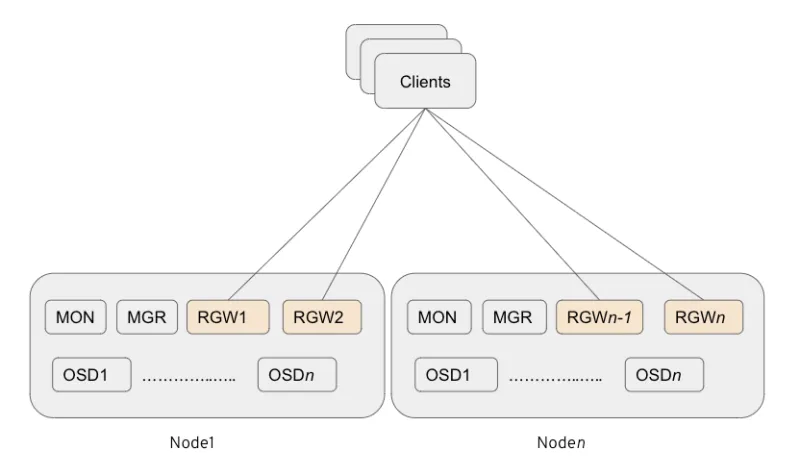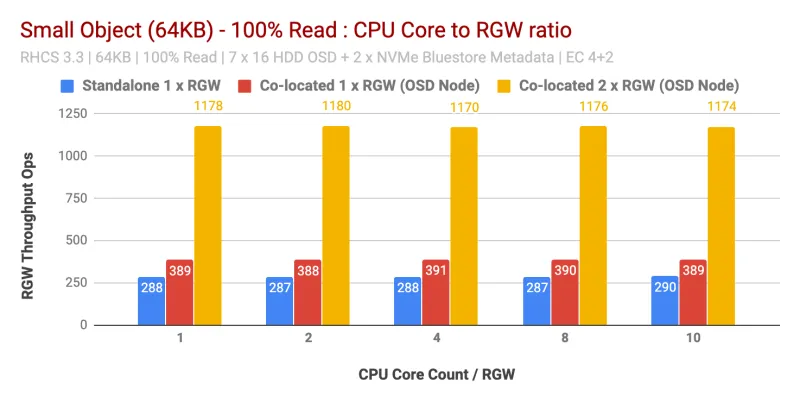Starting in Red Hat Ceph Storage 3.0, Red Hat added support for Containerized Storage Daemons (CSD) which allows the software-defined storage components (Ceph MON, OSD, MGR, RGW, etc) to run within containers. CSD avoids the need to have dedicated nodes for storage services thus reducing both CAPEX and OPEX by co-located storage containerized daemons.
Ceph-Ansible provides the required mechanism to put resource fencing to each storage container which is useful for running multiple storage daemon containers on one physical node. In this blog post, we will cover strategies to deploy RGW containers and their resource sizing guidance. Before we dive into the performance, let's understand what are the different ways to deploy RGW.
Co-located RGW
-
Does not require dedicated nodes for RGWs (can reduce CAPEX & OPEX).
-
A single instance of Ceph RGW container is placed on storage nodes co-resident with other storage containers.
-
Starting in Ceph Storage 3.0, this is the preferred way to deploy RGWs.

Figure 1: Co-resident RGW deployment strategy
Multi Co-located RGW
-
Does not require dedicated nodes for RGWs (can help reduce CAPEX & OPEX).
-
Multiple Ceph RGW instances (currently tested 2x instances per storage node) co-resident with other storage containers.
-
Our testing showed this option delivers the highest performance without incurring an additional cost.

Figure 2: Multiple co-resident (2 x RGW Instance) deployment strategy
Standalone RGW
-
Need dedicated nodes for RGWs.
-
Ceph RGW component get deployed on a dedicated physical / virtual node.
-
Starting in Ceph Storage 3.0, this is no longer the preferred way to deploy RGWs.

Figure 3: Standalone RGW deployment strategy
Performance Summary
(I) RGW deployment and sizing guidelines
In the last section, we looked at different ways to deploy Ceph RGW. We will compare the performance differences between each of these methods. To gauge the performance we executed multiple tests by modulating RGW deployment strategy as well as RGW CPU core count across small and large, write and read workloads. The results are as follows.
100% Write Workload
As shown in Chart 1 and Chart 2
-
Co-located (1x) RGW instance outperformed standalone RGW deployment for both small and large object sizes.
-
Similarly, multiple co-resident (2x) RGW instance outperformed co-resident (1x) RGW instance deployment. As such, Multiple co-resident (2x) RGW instances delivered 2328 Ops and 1879 MBps performance for small and large object size respectively.
-
Across multiple tests, the 4 CPU Core / RGW instance was found to be the optimal ratio between the CPU resources to RGW instance. The allocation of more CPU cores to the RGW instance did not deliver higher performance.

Chart 1: Small Object 100% write test

Chart 2: Large Object 100% write test
100% Read Workload Performance
Interestingly for read workload, increasing CPU cores per RGW instance did not deliver performance improvements for both small and large object sizes. As such results from 1 CPU core per RGW instance found to be almost similar to results from 10 CPU core per RGW instance.
In fact, based on our previous testing we observed similar results that read workloads do not consume a significant amount of CPU, perhaps because Ceph makes use of systematic erasure coding and does not need to decode chunks during read. As such, we found that if the RGW workload is read-intensive, over-allocating CPU does not help.
Comparing results from Standalone RGW to Co-located (1x) RGW test found to be very similar. However just by adding one more co-located RGW (2x) performance improved by ~200% in case of small object and ~90% in the case of large object size.
As such, if the workload is read-intensive, running multiple co-located (2x) RGW instances could boost overall read performance significantly.

Chart 3: Small Object 100% Read test

Chart 4: Large Object 100% Read test
(II) RGW thread pool sizing guidelines
One of the RGW tuning parameters which are very relevant while deciding CPU core allocation to RGW instance is rgw_thread_pool_size which is responsible for the number of threads spawned by Beast corresponding to HTTP requests. This effectively limits the number of concurrent connections that the Beast front end can service.
To identify the most appropriate value for this tunable we ran tests by varying the rgw_thread_pool_size together with CPU Core count pre RGW instance. As shown in chart-5 and chart-6, we found that setting rgw_thread_pool_size to 512 delivers maximum performance at 4 CPU core pre RGW instance. Increasing both CPU core count as well as rgw_thread_pool_size did not do any better.
We do acknowledge that this test could have been better if we had run a few more rounds of tests with lower rgw_thread_pool_size than 512. Our hypothesis is that since the Beast web server is based on an asynchronous c10k web server, it does not need a thread per connection and hence should perform as good with lower threads. Unfortunately, we're not able to test but will try to take care of this in the future.
As such multi-collocated (2x) RGW instance with 4 CPU Core per RGW instance and rgw_thread_pool_size of 512 delivers the maximum performance.

Chart 5: Small Object 100% Write test

Chart 6: Large Object 100% write test
Summary and up next
In this post, we learned that multi-collocated (2x) RGW instance with 4 CPU Core per RGW instance and rgw_thread_pool_size of 512 delivers the maximum performance without increasing the overall hardware cost. In the next post, we will learn what is / how to achieve maximum object storage performance from a fixed size cluster.
저자 소개
유사한 검색 결과
Red Hat's commitment to the EU Cyber Resilience Act: Shaping the future of cybersecurity standards
Data-driven automation with Red Hat Ansible Automation Platform
Technically Speaking | Platform engineering for AI agents
Technically Speaking | Driving healthcare discoveries with AI
채널별 검색
오토메이션
기술, 팀, 인프라를 위한 IT 자동화 최신 동향
인공지능
고객이 어디서나 AI 워크로드를 실행할 수 있도록 지원하는 플랫폼 업데이트
오픈 하이브리드 클라우드
하이브리드 클라우드로 더욱 유연한 미래를 구축하는 방법을 알아보세요
보안
환경과 기술 전반에 걸쳐 리스크를 감소하는 방법에 대한 최신 정보
엣지 컴퓨팅
엣지에서의 운영을 단순화하는 플랫폼 업데이트
인프라
세계적으로 인정받은 기업용 Linux 플랫폼에 대한 최신 정보
애플리케이션
복잡한 애플리케이션에 대한 솔루션 더 보기
가상화
온프레미스와 클라우드 환경에서 워크로드를 유연하게 운영하기 위한 엔터프라이즈 가상화의 미래
